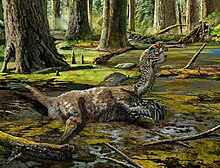Tongtianlong
| Tongtianlong | |
|---|---|

| |
| Holotype skeleton of Tongtianlong limosus | |
| Scientific classification | |
| Domain: | Eukaryota |
| Kingdom: | Animalia |
| Phylum: | Chordata |
| Clade: | Dinosauria |
| Clade: | Saurischia |
| Clade: | Theropoda |
| Family: | †Oviraptoridae |
| Genus: | †Tongtianlong Lü et al., 2016 |
| Species: | †T. limosus
|
| Binomial name | |
| †Tongtianlong limosus Lü et al., 2016
| |
Tongtianlong (meaning "Tongtianyan dragon") is a genus of
Description

Tongtianlong was a sheep-sized member of the oviraptorids, a group of omnivorous, feathered, bird-like theropods.[2] The describers of Tongtianlong recognized that it possessed a set of distinctive characteristics that differentiated it both from other oviraptorosaurs. In particular, unlike other oviraptorids, the crest of Tongtianlong was shaped like a dome, with its highest point just behind the eye socket; and the front edge of the toothless premaxilla, which would have supported its beak, was very rounded.[1]
Additionally, there is a distinct ridge on the front margin of the parietal bone, wedged between the frontal bones; the shaft of the lacrimal bone, which is located in front of the eye socket, is wide, flattened, and plate-like seen from the side; the foramen magnum (a hole in the back of the skull) is smaller than the occipital condyle (the boss forming the skull-neck joint); there is no ridge on the bottom of the front lower jaws, which is also not strongly downturned; and the xiphoid process does not flare out from the sternum behind the ribs. Other characteristics of the skull separate Tongtianlong from its contemporaries; for instance, the nostril is situated much higher than the antorbital fenestra, a trait seen otherwise only in Nemegtomaia and Rinchenia.[1]
Discovery and naming

The
The skeleton was preserved in an unusual pose, with a raised head and splayed arms; while it is difficult to tell exactly what led to this pose,[1] it has been speculatively suggested that the specimen died while it was trapped in mud and trying to free itself.[2] The genus name of Tongtianlong combines a reference to the nearby Tongtianyan (Chinese: 通天岩) grotto and the suffix -long (Chinese: 龍, "dragon").[4] "Tongtian" also is a Chinese phrase meaning "road to heaven". The specific name, limosus (the Latin word for "muddy"), refers to how the specimen was preserved in mudstone. It was first described and named by Lü Junchang, Chen Rongjun, Stephen L. Brusatte, et al.[1]
Classification

In 2016, Tongtianlong was found to be a member of the Oviraptoridae, as a close relative of Banji and Wulatelong. The results of the phylogenetic analysis conducted are partially reproduced below.[1]
| Oviraptoridae |
| |||||||||||||||||||||
Paleoecology

Tongtianlong is the sixth oviraptorid described from the Nanxiong Formation, after Banji, Ganzhousaurus, Jiangxisaurus, Nankangia, and Huanansaurus, in that order. Given the variation in size among these oviraptorids (for instance, Banji is much smaller than Tongtianlong), it is reasonable to hypothesize that some of them might be growth stages of others; however, it is more likely that they represent genuinely distinct animals, since juvenile oviraptorid specimens show that their anatomy does not change significantly with age.[5][1]
The describers of Tongtianlong suggested that this diversity is indicative of an evolutionary radiation of oviraptorids that occurred just prior to the Cretaceous–Paleogene extinction event.[3] However, the possibility that these species come from different points in time cannot be excluded, due to a lack of study on the stratigraphy and age of the Nanxiong Formation.[1]
See also
References
- ^ PMID 27831542.
- ^ a b c Gill, Victoria (10 November 2016). "Unknown dinosaur almost blown to oblivion". BBC News. Retrieved 10 November 2016.
- ^ a b Davis, Nicola (10 November 2016). "New species of 'weird bird'-like dinosaur discovered in China". The Guardian. Retrieved 10 November 2016.
- ^ "中国赣州南雄组晚白垩世第6个描述的新窃蛋龙科恐龙——泥潭通天龙" [The sixth new oviraptorosaurian dinosaur from the Late Cretaceous Nanxiong Formation of Ganzhou, China - Tongtianlong limosus]. 化石网 (Fossils Network) (in Chinese). Nanjing: Chinese Academy of Sciences. 11 November 2016. Retrieved 11 November 2016.
- S2CID 253640687.
